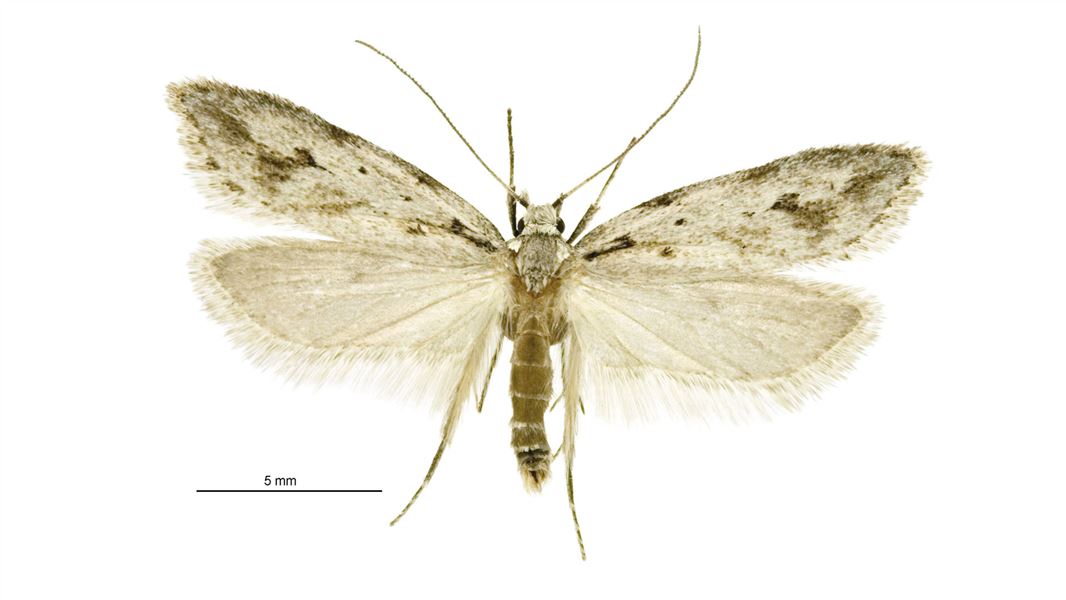Archived content: This media release was accurate on the date of publication.
Date: 04 March 2021
The 32-hectare reserve is the only known site for the cryptic grey-white moth, which depends on increasingly rare old growth shrubland to survive. Most of the shrubland in the reserve was destroyed by the fire in late August.
So DOC and Manaaki Whenua – Landcare Research staff were thrilled to rediscover Izatha psychra in a half-hectare pocket of undamaged shrubland during a survey in late January. Two males were caught and several others were thought to have been flying in the area.
DOC Ecology Science Advisor Eric Edwards was part of the team that rediscovered Izatha psychra. He says they were relieved to find the moths as there had been concerns the fire had wiped them out forever.
“If the fire had burned across this last half-hectare then it could have been a death-knell for the species.
“But this tiny fragment is now more vulnerable to risks like weed invasion, browsing animals, fire and drought. It leaves the moth in a precarious position.”
Eric says the moth has value as a species, but also as an indicator of health for a unique Canterbury drylands ecosystem that may be home to other rare plants and animals.
“These ancient ecosystems go back to the last ice age and are older than human history in New Zealand.”
The moths were found in a small gully that still had undamaged leaf litter, deadwood and lichens in it. This is important because the moth’s caterpillars are thought to live in one of those elements – though a caterpillar has never been found.
“While the fire-damaged shrubs in the reserve have started to resprout, it will take years for the lichen to regrow and leaf litter to build up, and for insects and other animals to reinhabit these ecosystems,” Eric says.
He says the expertise of Robert Hoare from Manaaki Whenua, including advice on light trapping, was crucial to rediscovering Izatha psychra.
DOC Twizel Senior Biodiversity Ranger Dean Nelson says work is underway to protect and restore the Pukaki Scientific Reserve, but its recovery will take a long time.
“A fence that was destroyed in the fire is being rebuilt to keep out pests like rabbits, wallabies and pigs, which have already started moving into the reserve and could slow the recovery of surviving native vegetation and regeneration of shrubs in the burnt area.
“Once the fence is finished, every effort will be made to remove these pests and tackle invasive weed species like cotoneaster and wilding pine.”
Dean says the fire is a harsh reminder of the damage these events can cause to New Zealand’s fragile ecosystems and rare biodiversity.
“It shows the importance of people taking care with fires when they are in the outdoors, because an out-of-control blaze can quickly threaten our special plants and animals.
“People should check it's safe and whether they need a fire permit on checkitsalright.nz before lighting any fires in the outdoors, and follow the advice on DOC’s website if lighting a fire on any public conservation land.”
Background information
Izatha psychra was first recorded near Porters Pass, in the Selwyn district, in 1884. It has not been seen there since the 19th century.
Very little is known about the life cycle of the species – less than a dozen Izatha psychra have ever been found. They have all been adult males about 20 mm long.
The moth’s adult phase lasts only a few weeks in January and February. They only come out at night. Their colouring means they would be extremely difficult to see when at rest on the shrubs they live in.
The Pukaki Scientific Reserve was established in 1996. The area had been recognised as significant for its montane shrubland from as early as 1976.
The reserve contains one of the only stands of montane scrub of its type on lateral moraines left in the district, with an abundance of aquatic and terrestrial insects.
The uncommon Rauparaha’s copper butterfly (Lycaena Rauparaha) has also been found there.
The fire started outside the reserve on 29 August 2020, burning through more than 3000 hectares.
Contact
For media enquiries contact:
Email: media@doc.govt.nz
